Podcast
Questions and Answers
What is the central feature of federalism?
What is the central feature of federalism?
- Exclusive national sovereignty
- Centralized decision-making
- Local government autonomy
- Shared sovereignty (correct)
In a unitary state, where does sovereignty typically lie?
In a unitary state, where does sovereignty typically lie?
- Both national and local governments equally
- National government (correct)
- Local governments
- Supranational entities
Which of the following describes a confederation?
Which of the following describes a confederation?
- Local governments are subordinate to national governments
- National governments have strong powers
- Sovereignty is distributed equally across all governments
- Sovereignty lies solely with subnational governments (correct)
Which factor is typically associated with countries adopting federalism?
Which factor is typically associated with countries adopting federalism?
Cooperative federalism primarily emphasizes which of the following?
Cooperative federalism primarily emphasizes which of the following?
Which scenario best describes coercive federalism?
Which scenario best describes coercive federalism?
Bicameralism in federal systems primarily serves what purpose?
Bicameralism in federal systems primarily serves what purpose?
Which of the following is a characteristic of quasi-federalism?
Which of the following is a characteristic of quasi-federalism?
What is an example of territorial federalism?
What is an example of territorial federalism?
How do courts influence federalism in a country?
How do courts influence federalism in a country?
In which type of federalism do federal and state governments have distinct responsibilities?
In which type of federalism do federal and state governments have distinct responsibilities?
Which of the following describes cooperative federalism?
Which of the following describes cooperative federalism?
What is a common issue in federal systems with bicameral parliaments?
What is a common issue in federal systems with bicameral parliaments?
Which type of federalism is characterized by local entities based on group membership?
Which type of federalism is characterized by local entities based on group membership?
What can result from having numerous opposing groups in a federal central government?
What can result from having numerous opposing groups in a federal central government?
In which type of federalism do local entities typically overlap on maps?
In which type of federalism do local entities typically overlap on maps?
What is an example of a country with strong federalism?
What is an example of a country with strong federalism?
Which factor does NOT typically lead to strong federalism?
Which factor does NOT typically lead to strong federalism?
Which of the following describes 'coercive federalism'?
Which of the following describes 'coercive federalism'?
The term 'laboratories of democracy' in the context of federalism refers to what concept?
The term 'laboratories of democracy' in the context of federalism refers to what concept?
Which of the following is a potential downside of federalism?
Which of the following is a potential downside of federalism?
Which statement best captures the relationship between geographic dispersion and federalism?
Which statement best captures the relationship between geographic dispersion and federalism?
What characterizes weak federalism?
What characterizes weak federalism?
Which of the following best explains the nature of bicameralism in federal systems?
Which of the following best explains the nature of bicameralism in federal systems?
In which scenario might a traditionally unitary state grant special autonomy?
In which scenario might a traditionally unitary state grant special autonomy?
Flashcards
Territorial Federalism
Territorial Federalism
A type of federalism where local entities are organized based on geographic boundaries.
Corporative Federalism
Corporative Federalism
A type of federalism in which local entities are formed based on shared group memberships, potentially overlapping geographically.
Dual Federalism
Dual Federalism
A type of federalism where federal and state governments have clearly defined and separate areas of power.
Cooperative Federalism
Cooperative Federalism
Signup and view all the flashcards
Federal Courts' Role
Federal Courts' Role
Signup and view all the flashcards
Bicameralism
Bicameralism
Signup and view all the flashcards
Federalism & Opposing Groups
Federalism & Opposing Groups
Signup and view all the flashcards
Representation in Federal Parliaments
Representation in Federal Parliaments
Signup and view all the flashcards
Federalism Definition
Federalism Definition
Signup and view all the flashcards
Unitary System
Unitary System
Signup and view all the flashcards
Confederation
Confederation
Signup and view all the flashcards
Federalism Scale
Federalism Scale
Signup and view all the flashcards
Federalism and Size
Federalism and Size
Signup and view all the flashcards
Shared Sovereignty
Shared Sovereignty
Signup and view all the flashcards
Quasi-Federalism
Quasi-Federalism
Signup and view all the flashcards
Federalism: Logistical challenges
Federalism: Logistical challenges
Signup and view all the flashcards
Federalism and Heterogeneity
Federalism and Heterogeneity
Signup and view all the flashcards
Federalism and Geographic Dispersion
Federalism and Geographic Dispersion
Signup and view all the flashcards
Federalism and External Threat
Federalism and External Threat
Signup and view all the flashcards
Federalism and Historical Autonomy
Federalism and Historical Autonomy
Signup and view all the flashcards
Federalism and Political Experimentation
Federalism and Political Experimentation
Signup and view all the flashcards
Federalism and Subsidiarity
Federalism and Subsidiarity
Signup and view all the flashcards
Strong Federalism
Strong Federalism
Signup and view all the flashcards
Federalism and Democracy
Federalism and Democracy
Signup and view all the flashcards
Federalism and Separatist Risks
Federalism and Separatist Risks
Signup and view all the flashcards
Study Notes
Federalism Definition
- Federalism is a political system with two distinct levels of government.
- Neither level is subordinate to the other.
- Shared sovereignty is the core principle.
Unitary States
- Sovereignty resides solely with the national government.
- Local governments' power derives from the national government's approval.
- Local governments usually have less power than in federal systems.
Confederations
- Sovereignty lies with the subnational / constituent governments.
- National governments have limited power.
- Not commonly used in nation-states (e.g., European Union is an example).
Federalism: A Scale
- The distinction between federal and unitary systems can be subtle.
- Federalism is a spectrum—many countries have aspects of both systems.
- Some unitary states grant significant powers to local governments (quasi-federalism).
- Spanning a spectrum; countries have aspects of both systems.
Reasons for Federalism
-
Large Size and Population: Larger countries face difficulties with centralized governance.
-
Federalism can reduce logistical problems for the government.
-
Typically, larger countries are federal; smaller ones are unitary.
-
This is based on easier logistical flow
-
Heterogeneity: Diverse populations make uniform governance challenging.
-
Federalism allows varying governance models.
-
This considers ethnic, cultural (linguistic), and religious differences
-
Geographic Dispersion: Federalism is common in dispersed countries with diverse geography.
-
It addresses logistical issues; local governance is more effective in local areas.
-
It is especially common for island nations or countries with dispersed geography.
-
External Threats: To address external threats, diverse groups can unite.
-
This can be used as a common defense tactic to combat external threats.
-
The USA is an example where federalism stemmed from an external threat.
History of Federalism
- Federalism can result from pre-existing autonomy that isn't related to diversity.
- The UAE exemplifies federalism arising from longstanding autonomous entities.
Ideological Reasons for Federalism
-
Laboratories of Democracy: Local entities can experiment with different policies.
-
Best practices arise from competitive policy experimentation.
-
Subsidiarity: Decisions should be made at the appropriate lowest level to optimize effectiveness.
-
This means local governments handle local processes to ensure effectiveness.
-
Independent Bases Of Power: Diverse bases of political power lead to a robust system of checks and balances from different entities leading to a strengthened democracy
Ideological Reasons Against Federalism
-
Combating Separatism: Local autonomy can lead to movements for independence.
-
This addresses the issue where the local governments may use their autonomy to gain independence
-
Incongruent Policies: Diverse local policies can create conflicts or inefficiencies.
-
Inconsistent outcomes can lead to conflict issues and challenges in implementation.
-
Political Chaos: Multiple levels of government can create gridlock and inefficiency.
-
This considers the issues where federal and local actions conflict, potentially hindering progress
Features of Federalism: Strength
- Weak Federalism: A strong central government dominates local entities.
- This leads to a less effective system but requires less disputes to manage.
- Strong Federalism: Balance exists between the local and central powers.
- This is a more robust system but may lead to more disagreements.
Factors Affecting Federalism Strength
-
Liberal Democracy Tradition: A strong tradition of checks and balances enhances federalism.
-
This leads to better-balanced outcomes for both entities.
-
Unity in Federal Government: A united government can exert greater central control.
-
This, in turn, can diminish the power of local entities.
-
Opposing Groups: Divided central government can result in stronger local powers.
-
This is because it leads to more disputes and challenges for the central government to handle, which, in turn, leads to stronger local power.
Bicameralism
- Federal parliaments typically have a bicameral structure.
- The upper house often represents local entities.
- Representation in the upper house can be based on population, or states may be overrepresented.
Importance of Courts
- Courts play a critical role in resolving conflicts between local and federal governments.
- Court decisions either strengthen or weaken federalism.
Types of Federalism
-
Territorial Federalism: Local entities are organized along territorial lines (states).
- This is a common way to delineate the borders of local and regional governments
-
Corporative Federalism: Local entities are based on group membership and may overlap geographically.
- This is a less common method of structuring local governments.
-
Dual Federalism: Clear separation of powers between federal and subnational units.
- Federal and subnational levels of powers are clearly divided
-
Cooperative Federalism: Federal and state/provincial governments share policy powers.
- Cooperation becomes more important.
-
Coercive Federalism: Federal government dominates state/provincial governments.
- State governments may become overly reliant on the federal government.
-
Asymmetric Federalism: Constituent entities have different levels of autonomy.
- Autonomy varies among the constituent units.
Studying That Suits You
Use AI to generate personalized quizzes and flashcards to suit your learning preferences.




